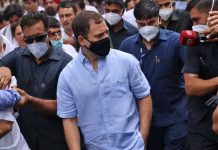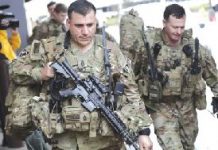US President Biden during his short visit has vowed ‘unflagging commitment’ to Ukraine. But whether he will concede Ukraine’s demand to arm it with more offensive weapons to take the war to Russian soil is yet not known.
During the initial weeks of January, 2023, the world was hopeful that the goddess of peace would finally prevail upon, and the avoidable unfortunate ongoing war between Russia and Ukraine would end before the conflict completes one year on February 24. Amidst the reports of informal peace talks, the optimism for an immediate ceasefire was expected, but the hope for an immediate truce vanished on February 20, just four days before the first anniversary of the conflict following the surprise visit of the US President, Joe Biden to Kiev, capital of Ukraine. Earlier, some unconfirmed in various media outlets were indicating that Washington had sent a secret mission involving some CIA functionaries to Moscow offering Russia to retain almost one fifth territory of Ukraine, mostly Russian speaking, it has already occupied. It is not known whether the Russian President, Vladimir Putin, rejected the offer, because Russia wants to control the Ukrainian ports.
There were also some reports in the Indian media that with a brief from the American security establishment, India’s National Security Advisor, Ajit Doval, too had explored the possibilities of peace with the Kremlin. Most of these reports, however, remain unconfirmed. Amidst these reports for peace initiatives, Biden’s sudden visit to Kiev has upset the prospects of an immediate peace in Europe. It is yet to ascertain whether, it would be paving the way for peace or it might be making the ongoing war more dangerous and fatal. The initial figures indicate that nearly 200,000 soldiers either have been killed or wounded in this conflict. The available UN statistics reveal that the Ukrainian side suffered casualties estimated to be 7199 civilians and 11756 other people including children. Gen Mark Milley, chairman of the US Joint Chiefs of Staff, has stated that around 40,000 civilians had died after being caught up in the conflict. He estimates that both sides have suffered an equal number of casualties, 100,000 each.
No wish to take war to Russian soil
On the eve of Biden’s visit to Ukraine, France and Germany, two major European powers, have announced larger supplies of weapons and ammunition to their ally. They, however, do not want to take the war to Russian soil. French President Emmanuel Macron has recently stated that he wanted Russia to be defeated in its war with Ukraine, but not “crushed”. After attending the Munich Security Conference, where he had pledged to intensify support to Ukraine, he, however, did not endorse the suggestion that the fight be taken on to Russian soil. After weeks of reluctance, Germany has agreed to send Leopard-2 tanks to Ukraine.
There were sharp reactions from the Russian side to the move. A government spokesman in Moscow, Dmitry Peskov, asserted that there was an overestimation of the potential of the new generation tanks and new weapons, but they would “burn like all the rest”. Anatoly Antonov, the Russian ambassador to Washington, has warned, “If the United States decides to supply tanks, then justifying such a step with arguments about ‘defensive weapons’ will definitely not work. This would be another blatant provocation against the Russian Federation.”
In spite of Biden’s visit to Ukraine, Macron states, “I am convinced that, in the end, this will not conclude militarily.” He said that neither side could fully prevail in the conflict.
The impact of the visit
During his short visit, Biden has vowed ‘unflagging commitment’ to Ukraine. He decided to travel to the war-torn country at a crucial moment in the war which is expected to intensify with both sides preparing for new offensives. However, it is yet to be assessed whether he would concede the demand of Ukraine to arm it with more offensive and fatal weapons to take the war to Russian soil.
It is not surprising that Biden has been eager to visit Ukraine for months. Earlier, his predecessors had been visiting the conflict zones. Obama, while secretly planning to evacuate NATO forces from Afghanistan had made a surprise visit to Kabul. Biden’s urge to visit Kyiv might have intensified following the visit of Macron, German Chancellor Olaf Scholz, Canadian Prime Minister Justin Trudeau, British Prime Minister Rishi Sunak, and others to Ukraine. He also experienced the air raids sirens howling over, when he and the Ukrainian president, Volodymyr Zelenskyy, were exiting the gold-domed St. Michael’s Cathedral during the brief visit.
It was natural for Zelenskyy to feel the security umbrella of the West, when the U.S. president was standing by his side on Ukrainian land. It, however, is to be seen whether this symbolism is materialised with the supplies of more advanced weaponry.
It is not known whether Moscow was given advance notice of the trip to avoid any miscalculation that could have brought the two nuclear-armed nations into direct conflict. It is rightly stated that the visit was a rare occasion where a U.S. president has travelled to a conflict zone where the U.S. or its allies did not have control over the airspace.
China accused of arming Russia
Beijing has strongly denied US claims that China was considering arming Russia in its war against Ukraine. It has reiterated for a dialogue to end the conflict. Just on the eve of Biden’s visit to Ukraine, US Secretary of State Antony Blinken had accused Beijing that it was now “considering providing lethal support” to Moscow ranging “from ammunition to the weapons themselves”. This allegation has been effectively countered by China’s foreign ministry spokesman Wang Wenbin that it is the United States and not China that is endlessly shipping weapons to the battlefield.
Biden’s unannounced visit to Ukraine is being stated to be a gesture of solidarity on behalf of the West. It was accompanied by an additional half-billion dollars in U.S. assistance with a promise that critical equipment, including artillery ammunition, anti-armour systems, and air surveillance radars to help protect the Ukrainian people from aerial bombardments,” would soon be delivered. It, however, is not known whether Zelensky’s demand for fighter jets to Ukraine would be conceded by White House.
The recent visit of Biden has not added to any peace initiative. The world is apprehensive of further expansion of the conflict in 2023.
BOX
NATO snub for Russia
Following the end of the communist regime in the USSR, the Russian Federation had dismantled the Warsaw Pact, and expected that the US-led western powers either would also end the security alliance, NATO, or allow Russia to join it. However, it appears that the traditional prejudices against the Russians resurfaced; Russia was denied entry into NATO, but most of the members of the erstwhile Warsaw Pact, were lured to the defence pact. Putin was alarmed when NATO tried to enrol Ukraine underlining the Russian strategic interests. It had alarmed Moscow so much that in 2014, Russia was forced to annex Crimea.
Russia flaunts weaponry
The sales of Russian defence equipment at the International Defence Exhibition and Conference, held in February at Abu Dhabi, Russia continues to occupy the position of a key player in the armament market. Much to the discomfiture of the USA, the Arab powers too have evinced their interests in Russian air defence systems — short, medium and long-range. The Turkish company, Baykar, had also displayed its giant armed drone along with the Russian helicopters in the exhibition.












